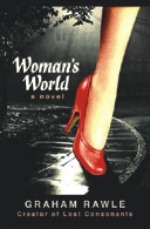|
Book Review
Powder and paste
Tom Phillips
 |
Woman's World
Graham Rawle |
From a modest smithy in the world of words that has, under the heading Lost Consonants, produced innumerable sparks, an epic engine has emerged. Woman's World may prove metafiction's first bestseller, and Graham Rawle become known as the Houdini of verbal escapology. Even the most dedicated players of jeux de mots (such as Georges Perec, who wrote a whole books without using the letter "e") have not within their chosen constraints wrought as truly persuasive a narrative as this bodice-donning yarn which shows no slip.
For five years Rawle, Stakhanovite of the scissors and paste, has laboured 17 hours a day, seven days a week, assembling 40,000 fragments of text from women's magazines to produce a tale that moves with the pace of a thriller, with as many cliffhanging chapter endings and swerves of story. But there's the added excitement of a typographical rollercoaster: each page features nearly 100 variations as we lurch from sedate Times Roman to the fullblown exclamations of advertisers' fancy capitals.
The magazines, whose blended recipe of romance and practicality provide the source material, date from the early 1960s, before The Beatles' first LP and all that special icon of phrases has come to imply. Readers of a certain age will tiptoe through the tulips of memory that nestle between Mantovani and Milk Tray, recollecting how hopefully they groped towards (among other then less mentionable things) the prawn cocktails of aspiration. Young women readers learned what to yearn for, though heartbreak warnings are posted on the shore of adventure. The misty fantasy in tales of love had long been definitively captured by Dylan Thomas when the hired help in Under Milk Wood gazes into the mirror and, in a magic couplet, sighs "call me Dolores / like they do in the stories".
The plot of Woman's World, while never losing sight of such desires of the lovelorn, is altogether more robust. It concerns Norma, a transvestite, and "her" alter ego, the terminally prosaic Roy. Their mother, the confused Mary, hovers in the flickering blue and white background where Have a Go is forever followed by Dixon of Dock Green. None of them has much grasp of reality; not even the caddish Hands, the necessary villain. Hope of redemption is offered, at least to Roy, by the crisply laundered heroine, Eve, but we know this prospect is doomed when the inner Norma gets too near Eve's heady wardrobe. Norma is a brilliant invention, allowing full lyrical use of the available material, which Rawle gathers and pleats into rhapsodic riffs of garment ecstasy.
An extended text needs to have more than novelty; the critical difference between a notion and an idea is that only the latter can generate and sustain intensity. Here the task is taken on with unflagging wit and psychological acumen. The wholeness of the project can be judged by a glance at such a humdrum detail as the page numbers, which are also garnered from the same magazines: "38" is followed by the well found "only 39?"; the last page, "437", is numbered with the smallest point-size in the book, as if to conceal by paradox the feeling of triumph and relief with which it must have been pasted on.
Only once or twice is there a concretist aberration whereby words fly at unconsidered angles as Rawle momentarily strays from the strict tempo of Victor Sylvester's Ballroom Orchestra. Otherwise the manner in which emphasis, tone and emotion go hand in hand with the collaged type, impossible to convey in ordinary quotation, is a shared adventure. Chapter 14, for example, starts with the words: "I hadn't wanted to touch the trousers." Already four typefaces are in play; the word "touch" is amplified to capitals 4.5 cm high while "trousers'" look unappealing in brushstroke italics. Here also, from 17 elements of text, is a simple description in the typical controlled rhythm of the book as a whole: "The balloon-faced old man was still there, but his attitude had changed. Perhaps he had overheard the hostilities. His assured expression had faded and now he seemed to wear the guarded, remote look of the puzzled physician. But he was also a very frightened, lonely old man. All alone ... like a cake on a plate."
I once saw the virtuosic John Tilbury play, recognisably, the opening movement of Tchaikovsky's First Piano Concerto with his back to the keyboard. It was a feat I never thought to see equalled, but this, as Rawle himself might say, eats everything.
Copyright
(R) thedailystar.net 2005 |
